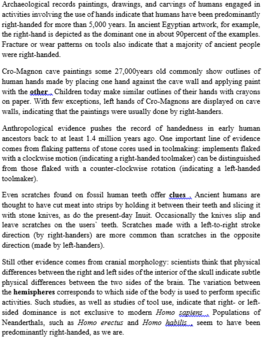Read the following passage and mark the letter A, B, C or D to indicate the correct answer to each of the questions from 36 to 42.
The concept of obtaining fresh water from iceberg that is towed to populated areas and arid regions of the world was once treated as a joke more appropriate to cartoons than real life. But now it is being considered quite seriously by many nations, especially since scientists have warned that the human race will outgrow its fresh water supply faster than it runs out of food. Glaciers are a possible source of fresh water that has been overlooked until recently. (A)
Three-quarters of the Earth's fresh water supply is still tied up in glacial ice, a reservoir of untapped fresh water so immense that it could sustain all the rivers of the world for 1,000 years. Floating on the oceans every year are 7,659 trillion metric tons of ice encased in 10,000 icebergs that break away from the polar ice caps, more than ninety percent of them from Antarctica. (B)
Huge glaciers that stretch over the shallow continental shelf give birth to icebergs throughout the year. Icebergs are not like sea ice, which is formed when the sea itself freezes; rather, they are formed entirely on land, breaking off when glaciers spread over the sea. As they drift away from the polar region, icebergs sometimes move mysteriously in a direction opposite to the wind, pulled by subsurface currents. Because they melt more slowly than smaller pieces of ice, icebergs have been known to drift as far north as 35 degrees south of the equator in the Atlantic Ocean. (C)
The difficulty arises in other technical matters, such as the prevention of rapid melting in warmer climates and the funneling of fresh water to shore in great volume. But even if the icebergs lost half of their volume in towing, the water they could provide would be far cheaper than that produced by desalination, or removing salt from water. (D)
Question 40: The word “currents” in the third paragraph is closest in meaning to ________.
A. pulls
B. waves
C. weather
D. flows of water







Đáp án D
Dịch nghĩa: Từ “currents” - dòng ở đoạn 3 gần nghĩa nhất với __________.
A. sự lôi kéo B. sóng C. thời tiết D. dòng nước
Giải thích: Thông tin nằm ở đoạn 2 “As they drift away from the polar region, icebergs pulled by subsurface currents” Khi chúng trôi đi, núi băng ...được kéo đi bởi dòng phía dưới mặt nước, hay rõ nghĩa hơn là dòng nước.